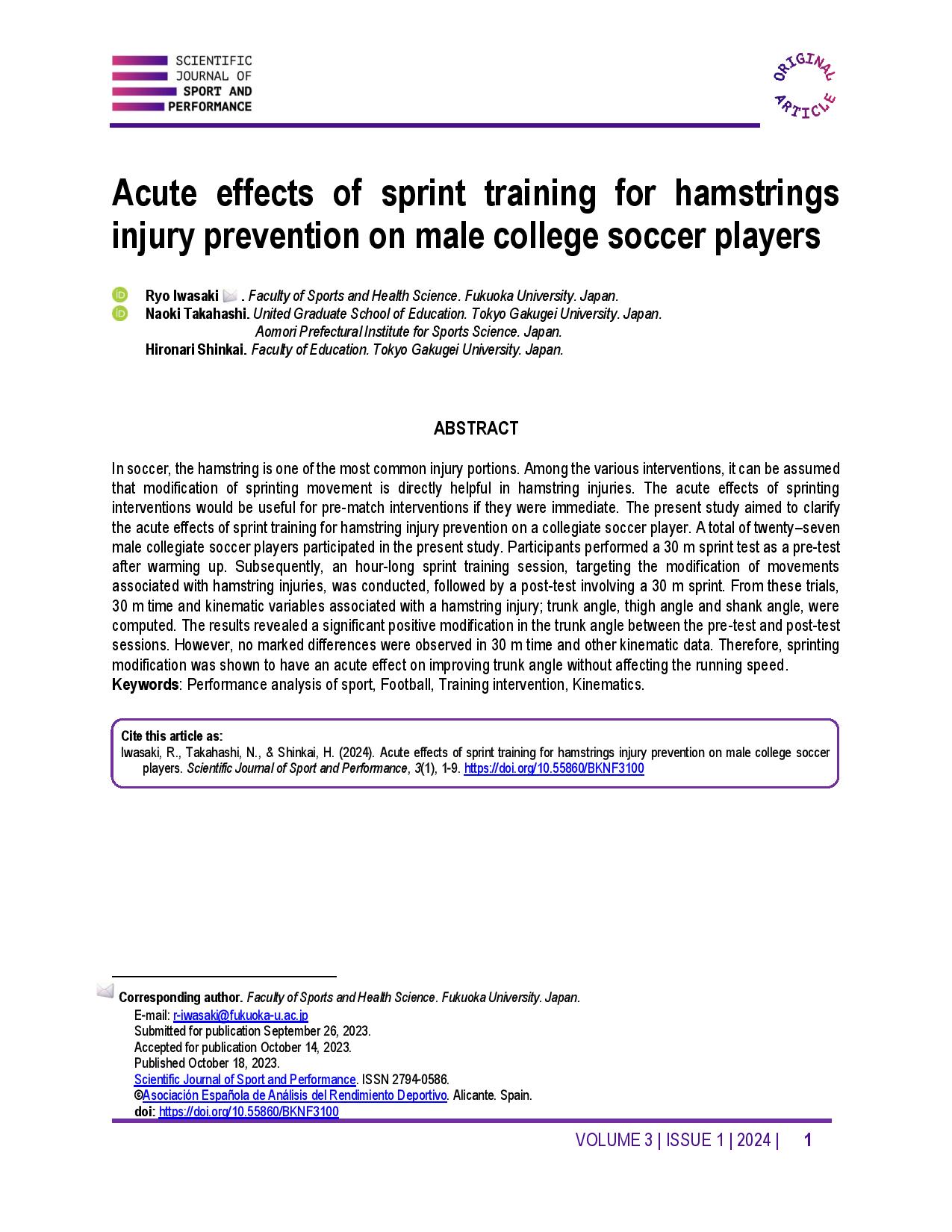Acute effects of sprint training for hamstrings injury prevention on male college soccer players
Main Article Content
Abstract
In soccer, the hamstring is one of the most common injury portions. Among the various interventions, it can be assumed that modification of sprinting movement is directly helpful in hamstring injuries. The acute effects of sprinting interventions would be useful for pre-match interventions if they were immediate. The present study aimed to clarify the acute effects of sprint training for hamstring injury prevention on a collegiate soccer player. A total of twenty–seven male collegiate soccer players participated in the present study. Participants performed a 30 m sprint test as a pre-test after warming up. Subsequently, an hour-long sprint training session, targeting the modification of movements associated with hamstring injuries, was conducted, followed by a post-test involving a 30 m sprint. From these trials, 30 m time and kinematic variables associated with a hamstring injury; trunk angle, thigh angle and shank angle, were computed. The results revealed a significant positive modification in the trunk angle between the pre-test and post-test sessions. However, no marked differences were observed in 30 m time and other kinematic data. Therefore, sprinting modification was shown to have an acute effect on improving trunk angle without affecting the running speed.
Article Details

This work is licensed under a Creative Commons Attribution-NonCommercial-ShareAlike 4.0 International License.
References
Bangsbo, J., Mohr, M., & Krustrup, P. (2006). Physical and metabolic demands of training and match-play in the elite football player. Journal of Sports Sciences, 24(7), 665-674. https://doi.org/10.1080/02640410500482529 DOI: https://doi.org/10.1080/02640410500482529
Barnes, C., Archer, D. T., Hogg, B., Bush, M., & Bradley, P. S. (2014). The evolution of physical and technical performance parameters in the English Premier League. International Journal of Sports Medicine, 35(13), 1095-1100. https://doi.org/10.1055/s-0034-1375695 DOI: https://doi.org/10.1055/s-0034-1375695
Clark, K. P., Meng, C. R., & Stearne, D. J. (2020). "Whip from the hip": thigh angular motion, ground contact mechanics, and running speed. Biology Open, 9(10). https://doi.org/10.1242/bio.053546 DOI: https://doi.org/10.1242/bio.053546
Clark, K. P., Ryan, L. J., Meng, C. R., & Stearne, D. J. (2021). Evaluation of maximum thigh angular acceleration during the swing phase of steady-speed running. Sports Biomechanics, 1-14. https://doi.org/10.1080/14763141.2021.1986124 DOI: https://doi.org/10.1080/14763141.2021.1986124
Cohen, J. (1992). A power primer. Psychological Bulletin, 112(1), 155-159. https://doi.org/10.1037/0033-2909.112.1.155 DOI: https://doi.org/10.1037/0033-2909.112.1.155
Ekstrand, J., Spreco, A., Bengtsson, H., & Bahr, R. (2021). Injury rates decreased in men's professional football: an 18-year prospective cohort study of almost 12 000 injuries sustained during 1.8 million hours of play. British Journal of Sports Medicine, 55(19), 1084-1092. https://doi.org/10.1136/bjsports-2020-103159 DOI: https://doi.org/10.1136/bjsports-2020-103159
Gronwald, T., Klein, C., Hoenig, T., Pietzonka, M., Bloch, H., Edouard, P., & Hollander, K. (2022). Hamstring injury patterns in professional male football (soccer): a systematic video analysis of 52 cases. British Journal of Sports Medicine, 56(3), 165-171. https://doi.org/10.1136/bjsports-2021-104769 DOI: https://doi.org/10.1136/bjsports-2021-104769
Haugen, T. (2017). Sprint conditioning of elite soccer players: worth the effort or lets just buy faster players. Sports Performance & Science Report, 4 (1), 1-3.
Haugen, T., Seiler, S., Sandbakk, Ø., & Tønnessen, E. (2019). The Training and Development of Elite Sprint Performance: an Integration of Scientific and Best Practice Literature. Sports Medicine - Open, 5(1), 44. https://doi.org/10.1186/s40798-019-0221-0 DOI: https://doi.org/10.1186/s40798-019-0221-0
Kanda, Y. (2013). Investigation of the freely available easy-to-use software "EZR" for medical statistics. Bone Marrow Transplantation, 48(3), 452-458. https://doi.org/10.1038/bmt.2012.244 DOI: https://doi.org/10.1038/bmt.2012.244
Mann, R., & Murphy, A. (2015). The mechanics of Sprinting and Hurdling. CreateSpace Independent Publishing Platform.
Mendiguchia, J., Conceição, F., Edouard, P., Fonseca, M., Pereira, R., Lopes, H., Morin, J.-B., & Jiménez-Reyes, P. (2020). Sprint versus isolated eccentric training: Comparative effects on hamstring architecture and performance in soccer players. PloS One, 15(2), e0228283. https://doi.org/10.1371/journal.pone.0228283 DOI: https://doi.org/10.1371/journal.pone.0228283
Mendiguchia, J., Castaño-Zambudio, A., Jiménez-Reyes, P., Morin, J.-B., Edouard, P., Conceição, F., Tawiah-Dodoo, J., & Colyer, S. L. (2022). Can We Modify Maximal Speed Running Posture? Implications for Performance and Hamstring Injury Management. International Journal of Sports Physiology and Performance, 17(3), 374-383. https://doi.org/10.1123/ijspp.2021-0107 DOI: https://doi.org/10.1123/ijspp.2021-0107
Nagahara, R., Matsubayashi, T., Matsuo, A., & Zushi, K. (2014). Kinematics of transition during human accelerated sprinting. Biology Open, 3(8), 689-699. https://doi.org/10.1242/bio.20148284 DOI: https://doi.org/10.1242/bio.20148284
Okudaira, M., Yamada, K., Kuki, S., Ota,K., Yoshida, T., Maemura, K., & Tanigawa, S. (2020). Three-dimensional sprint kinematics in elite collegiate soccer player in comparison with elite collegiate sprinters. Sprint Research, 28, 5-16. (in Japanese)
Opar, D. A., Williams, M. D., & Shield, A. J. (2012). Hamstring strain injuries: factors that lead to injury and re-injury. Sports Medicine , 42(3), 209-226. https://doi.org/10.2165/11594800-000000000-00000 DOI: https://doi.org/10.2165/11594800-000000000-00000
Sawilowsky, SS. (2009). New effect size rules of thumb. Journal of Modern Applied Statistical Methods, 8(2), 597-599. https://doi.org/10.22237/jmasm/1257035100 DOI: https://doi.org/10.22237/jmasm/1257035100
Schuermans, J., Van Tiggelen, D., Palmans, T., Danneels, L., & Witvrouw, E. (2017). Deviating running kinematics and hamstring injury susceptibility in male soccer players: Cause or consequence? Gait & Posture, 57, 270-277. https://doi.org/10.1016/j.gaitpost.2017.06.268 DOI: https://doi.org/10.1016/j.gaitpost.2017.06.268
Stølen, T., Chamari, K., Castagna, C., & Wisløff, U. (2005). Physiology of soccer. An Update. Research in Sports Medicine , 35(6), 501-536. https://doi.org/10.2165/00007256-200535060-00004 DOI: https://doi.org/10.2165/00007256-200535060-00004
van Beijsterveldt, A. M. C., van der Horst, N., van de Port, I. G. L., & Backx, F. J. G. (2013). How effective are exercise-based injury prevention programmes for soccer players? : A systematic review. Sports Medicine , 43(4), 257-265. https://doi.org/10.1007/s40279-013-0026-0 DOI: https://doi.org/10.1007/s40279-013-0026-0
Walton, JS. (1981). Close-range cine-photogrammetry: A generalized technique for quantifying gross human motion. Pennsylvania State University.
Winter, D. A. (2009). Biomechanics and Motor Control of Human Movement. 4th ed. Hoboken, N.J: John Wiley & Sons. https://doi.org/10.1002/9780470549148 DOI: https://doi.org/10.1002/9780470549148




